 This post continues my series on how I try to understand an unfamiliar shop floor. In the last post I talked about how to see visual management, 5S, and waste. These are usually easy to see. This post continues with unevenness, overburden, and safety, which are usually harder to observe.
This post continues my series on how I try to understand an unfamiliar shop floor. In the last post I talked about how to see visual management, 5S, and waste. These are usually easy to see. This post continues with unevenness, overburden, and safety, which are usually harder to observe.
Unevenness
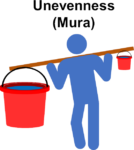 Unevenness, or in Japanese mura, is any kind of unevenness or irregularity or fluctuation. This is particularly difficult to observe for the iterations of a process. To see waste, one iteration already gives you some indications on where waste happens. For unevenness, however, you need to see multiple iterations to observe the differences between the iterations. It really helps if there is a work standard. Is the employee following the standard or not?
Unevenness, or in Japanese mura, is any kind of unevenness or irregularity or fluctuation. This is particularly difficult to observe for the iterations of a process. To see waste, one iteration already gives you some indications on where waste happens. For unevenness, however, you need to see multiple iterations to observe the differences between the iterations. It really helps if there is a work standard. Is the employee following the standard or not?
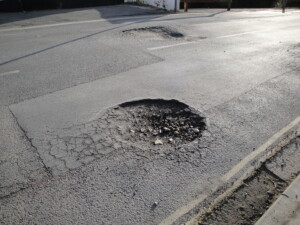 It may be even more difficult to observe for quality issues. Material or products where the quality varies or fails is also an unevenness. However, due to the (hopefully) low occurrence of defects, you may have to observe thousands or millions of parts to understand quality, which is just not doable in reality. Hence, to understand quality, you usually need data collected over time.
It may be even more difficult to observe for quality issues. Material or products where the quality varies or fails is also an unevenness. However, due to the (hopefully) low occurrence of defects, you may have to observe thousands or millions of parts to understand quality, which is just not doable in reality. Hence, to understand quality, you usually need data collected over time.
Similarly, a fluctuating demand or a fluctuating supply is also more difficult to observe directly, but can be observed indirectly through inventory (where does it pile up, where is it missing?), or data on inventory fluctuations and demand/supply fluctuations. The same applies to fluctuations in the output speed for a process.
In general, unevenness is much easier to observe in the material flow. What are your lot sizes? The vision for the perfect lot size is one, albeit depending on your factory this may not really be feasible. But it can be observed easily. The same applies for transport sizes, which may be the same as lot sizes… but they could also differ. Do you see boxes full with material, and other boxes half filled with material?
Also reasonably easy to observe are differences in labeling. For example, is the information for material always at the same spot on the box, or does this differ? Is it even the same type of box for the same type of parts? Differences here may not necessarily be wrong, but they do indicate yet another fluctuation.
Breakdowns are also fluctuations. Since they stop the entire process, they are also often easy to see. How many machines on the shop floor are running, how many are idling, and how many do have some sort of problem? Similarly, idle employees are also a sign of fluctuation (but please don’t blame the employees for it—it is usually a management issue). Anything but normal working is a type of fluctuation. Finally, workers having different levels of training is also a fluctuation, but again this is hard to observe.
Overburden
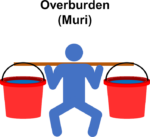 I recently wrote an entire post on overburden, or in Japanese muri. It is commonly called overburden, but the proper translation “unreasonableness” is in my view a better description of muri. It is any kind of overload or stress, mostly on people, but also on machines, materials, or the organization in general. Toyota considers this the worst of the three evils (waste, unevenness, overburden). It is also one that is difficult to observe… but it is possible. In Japan, there are also the famous 3K, standing for kitanai (汚い), kitsui (危険) and kiken (きつい) for dirty, dangerous, and demanding work.
I recently wrote an entire post on overburden, or in Japanese muri. It is commonly called overburden, but the proper translation “unreasonableness” is in my view a better description of muri. It is any kind of overload or stress, mostly on people, but also on machines, materials, or the organization in general. Toyota considers this the worst of the three evils (waste, unevenness, overburden). It is also one that is difficult to observe… but it is possible. In Japan, there are also the famous 3K, standing for kitanai (汚い), kitsui (危険) and kiken (きつい) for dirty, dangerous, and demanding work.

One key way to observe is on safety… but that is so important that I gave it a separate section below. I also try to look for physical or mental strain. Is the workplace ergonomic? Are parts and tools easy to reach? For this, I rather be overcautious. It is usually no problem to get something from a hard to reach or uncomfortable spot. But doing this eight hours a day will grind people down. This may also be different different people.
Are the tools well maintained and in proper order? We already looked for this when analyzing 5S, but dirty or broken or even completely missing tools are also symptoms of overburden. In general, a lack of resources to do the work is overburden. This may also include a lack of time to do a project, tight deadlines, or a lack of space. A lack of training is also overburden. Overarching a lack of respect is also overburden and unreasonableness.
 Unfortunately, most of them are hard to actually observe. What IS observable is for example sanitation. I love to visit the employees’ bathroom on a plant visit. And by that I do not mean the usually clean office bathrooms, but the often much less clean bathroom on the shop floor. How does it look? How does it smell? Would you feel comfortable using it? The same applies to your people.
Unfortunately, most of them are hard to actually observe. What IS observable is for example sanitation. I love to visit the employees’ bathroom on a plant visit. And by that I do not mean the usually clean office bathrooms, but the often much less clean bathroom on the shop floor. How does it look? How does it smell? Would you feel comfortable using it? The same applies to your people.
I also try to see if people look happy, or at least somewhat comfortable. Lots of unhappy faces are also an indication of overburden and unreasonableness, albeit it is difficult to find the root cause merely by knowing that people are not happy.
Hence, if you know what to look for, you can see probably plenty of examples of overburden. Just like waste, however, you will not be able to get rid of all of them. Even the best work is sometimes a drag. And seeing an example of overburden does not mean that you need to act on that.
Safety
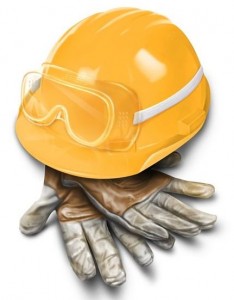 Finally, the last thing to look for on the shop floor is safety. This should be the most important aspect to check, even though I put it at the end of the list of 5S, visual management, waste, unevenness, and overburden. It is at the end, since it is actually part of overburden, and I looked at overburden last since it is most difficult to see, and seeing easier parts like waste first helps you later on with the more difficult aspects.
Finally, the last thing to look for on the shop floor is safety. This should be the most important aspect to check, even though I put it at the end of the list of 5S, visual management, waste, unevenness, and overburden. It is at the end, since it is actually part of overburden, and I looked at overburden last since it is most difficult to see, and seeing easier parts like waste first helps you later on with the more difficult aspects.
When looking at safety, I try to see anything related to safety. Are there any dangerous spots, uneven floors, sharp metal parts, or hazardous chemicals? Equally important: Do people wear their safety gear? Safety glasses and hard hats are not always popular but can save lives.
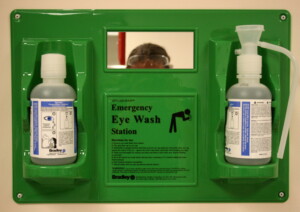 On a more formal note, I look at whether emergency exits are labeled and unblocked, if fire extinguishers are labeled and maintained, and if the first aid kits are still good and also complete. In my experience, especially emergency eye washing bottles have a tendency to leak. But also first aid kits are often understocked and sometimes out of date. Luckily, all of these are easy to fix.
On a more formal note, I look at whether emergency exits are labeled and unblocked, if fire extinguishers are labeled and maintained, and if the first aid kits are still good and also complete. In my experience, especially emergency eye washing bottles have a tendency to leak. But also first aid kits are often understocked and sometimes out of date. Luckily, all of these are easy to fix.
This concludes what I usually look at on the shop floor to understand the state of the production. However, as mentioned a few times above, not everything is easy to see directly yourself. Sometimes, you also need to look at already collected and maybe even analyzed data… but more on this in the next post. Now go out, look at your shop floor to make it safe and reasonable for your employees, and organize your industry!

This article has given me a better understanding of the importance of inequalities, especially in the flow of materials, and how they can affect the manufacturing process. I didn’t know the concept of muri, which I find very interesting. The concept of “muri” addresses overloads primarily on people, but also on machines, materials, and the overall organization. Finally, the focus on safety, related to overload, emphasises the importance of creating safe and efficient work environments.
Do you know what specific actions can be taken to create more balanced and efficient working conditions?
Hello Louis,
“more balanced and efficient working conditions” are usually a lot of work on the details. Look for fluctuations, and try to turn them off. If it would be a computer game, this would be the “grinding” phase…
You’re definitely spot on about about the worst wastes also being some of the most difficult to see. Especially for an outsider who only spends a very limited amount of time on the production floor.
You’re also walking into the similar that traditional accounting deals with, where something that can’t be easily seen or measured is assumed to be zero.
As far as messy bathrooms go, I’m sure you’ve seen it happen more than once where a big wig visitor notices a rough looking bathroom, a couple workers get scrambled up to shine it up, and everyone collectively goes “mission accomplished”, while other real and persistent issues keep going on like nothing ever happened.
Speaking of bathrooms, employee break areas are another frequent inspection item. of course, most managers know from past experience to give them extra cleaning in case of any big wig visit in the near future to make things as smooth and painless as possible until the big wig leaves and it’s everybody back to normal.
This article provides a fascinating insight into the various aspects of assessing a production facility. I found the discussion on unevenness and overburden particularly intriguing, as they are often hard to spot but can have a significant impact on efficiency and safety. The exploration of the concept of ‘muri’ and the importance of creating safe work environments has given me a fresh perspective. Regarding the creation of balanced and efficient working conditions, it would be interesting to learn about specific actions that can be taken in practice to minimize unevenness and overburden.
Hi Jana, especially fpr unevenness (mura) I have a series of blog posts on a Structure for Reducing Fluctuations. Hope it helps.